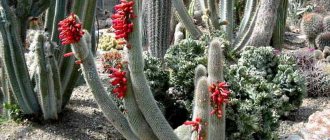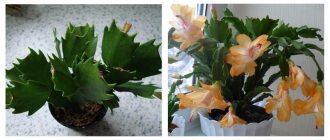Caring for Cereus at home
These cacti are considered unpretentious.
They do not need to select a special soil composition or carefully monitor temperature and lighting. Due to their hardiness, Cereus is often used as a rootstock for more delicate and capricious species of cacti. With the help of grafting, breeders have developed many new, extremely beautiful and decorative varieties of cacti.
Lighting
Cereus like good, bright light at any time of the year. If you have a choice, it is better to place these plants on the south and southeast side of the house.
Although Cereuses love direct sunlight, there is a danger of sunburn in spring and summer. To protect cacti, you need to gradually accustom them to the sun after winter.
Temperature
The optimal temperature in winter is from 8 to 12 degrees. In warm times, cereus plants tolerate heat and daily temperature changes well. In summer and early autumn, you can keep these cacti on your balcony or open veranda.
Watering
Water for irrigation should not be cold or too hard. In spring and summer they water moderately, in the fall they gradually reduce watering, and in winter they practically stop. Excess moisture is harmful to these plants, they quickly begin to look weak and get sick.
In the warm season, it is useful to spray the cereus with clean warm water.
Top dressing
Cereuses grow rapidly and therefore require additional feeding. The best time for this is from mid-spring to mid-summer. You can use liquid fertilizers, or simply water them with water enriched with microelements.
If the cactus has just been transplanted, no feeding is required for at least two to three weeks: there are enough nutrients in fresh soil.
The soil
The soil should be neutral or acidic, but not alkaline. The soil mixture should include sand and brick chips.
Cereus are not suitable for rich soils with a lot of humus.
Rest period
The wintering place should be bright and warm. It is not recommended to rotate the plant relative to sunlight.
In winter, cacti are not fed and watered very rarely.
Transfer
Depending on the growth rate of cacti, they can be replanted annually, or once every two years. The pot should be wide and deep enough.
Reproduction
In nature, Cereuses reproduce by seeds. Occasionally, parts broken off from the stem can take root; this is an analogue of propagation by cuttings. At home, rocky forms of cacti are propagated only vegetatively - by cuttings.
Cuttings are obtained from cut shoots dried for several days. It is best to separate them in the spring, or in the first half of summer. The prepared cuttings are planted in a shallow pot with suitable soil and lightly moistened. After 2-4 weeks, the cuttings are accepted. Then the young cacti can be planted and watered as usual.
Propagation by seeds at home begins in the second half of spring. The soil in the container with seeds should be constantly moist, but not excessively. Until the shoots appear, the pot can be kept in the shade, then moved to a lighted place, but not in direct sunlight. The best temperature is from +18 to +20 °C.
Young cacti will develop spines in 3-4 weeks. At this time or a little later they can be seated.
Types and varieties of Cereus cactus
There are all sorts of species found in the wild. Many of them are grown as ornamental houseplants. The Cereus flower will become a real decoration for the interior of any room. The tireless work of breeders allows us to contemplate a large number of varieties, which may be small or not very large. Some bloom profusely, while others have flowers that are very rare. There are even nocturnal cacti, whose flowers bloom only at night.
What do Cereus cacti look like?
Peruvian cereus cactus
The Peruvian cactus is also called rocky. It is very common in Russia. The plant has an elongated cylindrical stem. Unusual notches are formed along the edges, directed from bottom to top. The stem has a rich green color with a characteristic gray tint. At home, subject to agrotechnical rules, the height reaches 0.5 meters. Rarely, cases have been recorded when the height reached 1 meter.
Note! Echinocereus Pectinatus is considered to be the founder of all species and subspecies of cactus.
During flowering, white flowers are formed, the petals of which open only in the dark. During this period, the culture exudes a pleasant fruity aroma. After flowering, a red berry is formed, suitable for consumption.
Cereus peruvianus
Cereus monstrosa
This variety is a subspecies of the Peruvian cactus. In the wild, its height can reach 6 meters, and its diameter is about 5 meters. It is characterized by an unusual shape: the stem grows in an arbitrary direction, forming various simple shapes. The plant does not bloom; annual growth of greenery is approximately 1 meter.
This crop is also grown at home. The stem is actively growing. Shapes and sizes can be very diverse.
Cereus monstrous rocky
Chamecereus cactus
Chamecereus belongs to the cactus family. They grow in the wild in Argentina. It is a low-growing, small-sized plant that is perfect for decorating rooms. Forms stems about 15 cm high and light green in color. Their surface is abundantly strewn with light needles. The plant is prone to branching and begins to bloom for the first time during the 3-4 growing season.
Attractive funnel-shaped flowers of brick or bright red color are formed. The size is large, reaching 7-8 cm in diameter. It reproduces by seeds and shoots.
Chamecereus cactus
Note! It is recommended to grow a cactus in a cramped pot, otherwise it will not bloom.
Echinocereus cactus
In the wild, this succulent grows in the southern regions of North America. But at the same time, it is often grown on windowsills as a decorative addition. It reaches a height of no more than 0.6 meters. The stem has a cylindrical shape, rounded on all sides. It branches strongly, forming a large number of shoots. The needles are grouped in bunches and have a light color.
During flowering, large pink funnel-shaped flowers are formed. After flowering, a tasty, edible and healthy fruit is formed.
Echinocereus plumosus cactus
Other types
The Peruvian succulent has many other varieties that are grown at home:
- The giant cereus can reach a height of 20 meters. The stem is branched and quite dense. Under favorable weather and climatic conditions, it blooms from May to June, at which time large flowers of green, orange, red and yellow colors are formed. Afterwards, tasty edible fruits are formed in their place.
- Cereus azure got its name due to the color of the stem. It has a slight bluish tint. The stem is cylindrical, straight, with ribs strewn with needles. During flowering, white, funnel-shaped flowers are formed.
- The Oreocereus cactus has a branched stem, the length of which is about 8 cm. The needles have different colors: white, yellow and red. The crop begins to bloom on average in the tenth year of the growing season. The flowers are brick, lilac and purple in color.
- The cephalocereus cactus has a cylindrical stem, its height varies between 10-20 cm. The main characteristic feature is the presence of white hairs on the stem. Thanks to them, the cactus looks fluffy. At home, the plant does not bloom.
- Echinocereus knipple is characterized by the presence of an elongated stem with ribs, which are abundantly strewn with white needles. During flowering, soft pink flowers are formed that visually resemble chamomile.
- Echinocereus rubrispinus is a low-growing crop with white needles on the stem. Blooms in spring with large pink flowers.
You can purchase the plant at any specialty store.
Diseases and pests
Cephalocereus are quite resistant to various diseases and insect pests. However, unsuitable conditions for cacti can contribute to the appearance of mealyworms and red flat mites.
Therefore, the “hair” of the plant must be periodically checked for the presence of unwanted inhabitants.
Also, spider mites can get onto the cactus with street air.
To prevent its occurrence, it is necessary to spray cacti with any anti-tick product twice a year - in spring and autumn.
Be especially careful if you take Cephalocereus outside or place it near an open window.
Pests and diseases
Pests and diseases are not a problem for Hageocereus if all measures and conditions for plant care are followed. But regular violation of the rules and conditions can easily trigger the onset of symptoms of non-communicable diseases. A common problem with Hageocereus is root rot, which occurs when watering conditions are regularly violated and is provoked by bacteria.
Advance care and attention can protect the cactus from this trouble. If there is rot, the plant must be treated with chemical or biological preparations and transplanted into new soil.
But every gardener must remember that the fight against rot is less effective than the desire to prevent its occurrence.
And for those who like to know more, we invite you to watch the video about Hageocereus
Rules for caring for a cactus
Follow simple recommendations for caring for the plant.
Watering mode
Echinopsis needs little water at home. During the active season, gardeners advise watering the cactus in meager portions of 2 r. in Week. Moreover, water should be poured in a thin stream onto the top of the plant. Between waterings, the soil should dry out to half its depth. In winter, the procedure may not be carried out at all.
Feeding technique
Echinopsis will benefit from a special universal fertilizer for cacti and succulents. The feeding period is from March to September. Apply the mixture at the manufacturer's recommended dose once a month.
Advice. Glucose also has a beneficial effect on cactus. Sometimes add a little sugar to the water for irrigation.
Pruning and replanting procedures
Cactus is not the type of plant that needs pruning. But he absolutely needs a transplant. Every year, in early spring, a young specimen of Echinopsis is moved to a pot of slightly larger diameter. Adult plants are replanted every 2-3 years, also in March. They do not need additional space; it is enough to simply replace the soil with fresh, nutritious soil.
Operating procedure:
Stop watering 6-8 days before. This will help make the roots resistant to rot and stress after transplanting. Fill the bottom of the pot with a layer of drainage. Apply a small layer of prepared soil. Carefully remove the cactus. Remove the "babies". Place the Echinopsis in a new pot. Sprinkle the rest of the soil
It is important that it does not touch the above-ground green part of the plant. Using your fingers, lightly compact the substrate around the stem. Water
Protect from direct sun for several days.
It is important to know! Large old specimens are not replanted at all. In a pot with them, simply remove and replace the top layer of soil mixture
The thickness of the renewed soil is 5 cm.
Threat to decorativeness: diseases and pests
If the cactus simply does not bloom, most likely you violated the growing technique: you did not keep the echinopsis cool or did not provide it with good light. Otherwise, study the plant. Perhaps it got sick:
- Darkened areas on the green stem indicate rotting of the roots. This happens with regular overflow. Cut off the affected areas and treat the cut with a fungicide.
- A cobweb in a pot indicates the presence of a spider mite. Remove it manually or treat the plant with an insecticide.
Diseases and pests
The Cereus cactus often becomes a target for various insects. Most often this is a scale insect that consumes plant sap, a spider mite, the appearance of which is symbolized by whitish spots with villi. We must not forget about the mealybug, as a result of the invasion of which red dots and even cobwebs appear on the leaves, which after some time are complemented by icteric spots. Destruction of any type of pest is possible using insecticides.
The Cereus cactus often suffers from rot. The appearance of this disease can be determined by soft brown spots located on the shoots. In this case, the rot will first have to be cut off with a knife and then the wound will be treated. Since putrefactive manifestations most often occur due to improper irrigation, it will be enough to temporarily reduce watering and then adjust the system.
How to transplant the Cereus cactus, see the video below.
2. Chamecereus care at home
2.1. Temperature conditions
In spring and summer, they are kept at a temperature of 18 - 25 ° C. For abundant flowering in the winter months, plants are immersed in a cool dormant period, which should take place at a temperature of 8 - 10 ° C.
2.2.Lighting
The plants are photophilous and will enjoy direct sunlight in the morning and evening hours. Give cacti some shade on hot summer days. In autumn and winter it is worth providing the most illuminated place.
Chamecereus is hardy and forgives some mistakes of novice gardeners.
2.5.Feeding
During the period of active growth, feed with water-soluble fertilizers for cacti and succulent plants at half strength, monthly. During the dormant period, fertilizing is not carried out.
2.6.Purpose
Low-growing, indoor-flowering plants for well-lit areas. Chamoecereus in lodging stems look great in a hanging basket.
Late spring – early summer.
2.8.Air humidity
Does not require spraying. During the fall and winter, keep the cactus in a dry atmosphere and provide it with sufficient air movement without cold drafts.
2.9.Soil moisture
Water abundantly, completely soaking the soil with moisture, dry the top layer of the substrate to a depth of 2 - 3 cm before each subsequent watering. During the fall, the frequency of watering is gradually reduced and during the winter months the plants should be in almost dry soil. Slightly shriveled stems will indicate the need for watering at this time.
2.10.Transfer
Since this cactus has a shallow root system, you can choose wide bowls for planting. Transplantation is carried out in the spring, annually
Transplanted plants are watered with caution
2.11.Reproduction
Stem cuttings of Chamecereus easily take root even for novice cactus growers, in spring and summer in wet sand. The place where the cuttings are cut is dried for several days before planting. Seeds.
2.12.Pests and diseases
Like most cacti, it rots easily if there is excess moisture, especially during the dormant period. When grown in partial shade, plants become elongated and unsightly.
Red mites, mealybugs, thrips and aphids sometimes appear.
Insects - pests
| Insect name | Signs of infection | Control measures |
| Mealybug or feltworm | The surface of the leaves and shoots is covered with a fluffy, cotton-like white coating. Plants lag behind in development | Folk remedies: spraying with soap and alcohol solution. Infusions of tobacco, garlic, cyclamen tubers, alcohol treatments, and pharmacy tincture of calendula have worked well. Chemicals: green soap solution, Actellik, Fitoverm. |
| Spider mite | Inconspicuous cobwebs on the leaves, yellowing and falling leaves with extensive damage. The surface of the leaf plates becomes dead and covered with small cracks. Plant development slows down. | Folk methods. Plants can be washed in the shower and left in the bathroom in a humid atmosphere for half an hour. Irradiation with an ultraviolet lamp every week for 2 minutes. Chemical preparations based on pyrethrum, sulfur powders, Fitoverm, Actellik. |
| Aphid | Sticky droplets appear on the leaf blades, the leaf blades curl and become deformed, tender buds and young leaves wither. Colonies of insects can be seen on the tips of shoots, buds or the underside of leaf blades. The flowers of plants affected by aphids may become deformed. | Folk methods: nettle infusion, decoction of rhubarb leaves, wormwood, soap solution, infusion of tobacco and dandelion, onion, marigold, yarrow, tansy, dusting with wood ash. Chemicals: Sulfur powders, treatment of green mass with green potassium soap without getting into the ground, Decis, Actellik, Fitoverm. |
| Trips | The appearance of yellow spots on the leaf blades; small brown dots can be observed on the underside of the leaves. When pests spread, they cause leaves to turn yellow, dry out and fall off. | Folk methods. Increase air humidity, wipe the surface of the leaves with a soap solution to reduce the number of pests. Preparations based on pyrethrum - 2-fold treatment with an interval of 7 - 10 days, spraying with tobacco infusion, infusion of yarrow or Persian chamomile, decoction of cyclamen tubers. Chemical preparations: dusting with sulfur powders, using anabasine sulfate in a soap solution. |
- Mealybug or feltworm
- Spider mite
- Aphid
- Trips
2.13.Note
Young shoots can easily break off from the main plant when transplanted.
Hydroponics.
You might also be interested in:
Echinopsis
Cylindropuntia
Rebutia
Epiphyllum
Botanical description and homeland of the plant
Cereus (lat. Cereus) is a giant among cacti, its height is 6-10 m, there are twenty-meter representatives.
It breaks records for life expectancy, as it can grow in nature for up to 300 years. In total, there are 50 species of cereus, common in South and Central America and the West Indies. Most of them are tall, well-branching shrubs; there are low-growing and creeping plants (clinging with the help of lateral shoots).
Cereus is characterized by a cylindrical structure of shoots, divided into several well-defined edges. Against the background of the green-gray tint of the stems and shoots, the dark brown, almost black spines stand out, although at first they are almost white. The name of the plant is translated from Latin as “wax candle”.
Cereus is perfect for growing indoors: it is not demanding, reproduces well, grows quickly and has proven itself to be an excellent rootstock. A highly decorative plant will decorate a room, winter garden, or shop window. Cereus is often used to create cactus slides.
Cereus flowering
How Peruvian Cereus blooms photo
In nature, Cereus regularly blooms in May-June; the bush is decorated with many corollas. In indoor conditions it can bloom in the fall, of course there are not so many corollas. Flowers are located laterally (on the side of the shoots). They are large, the petals are snow-white, beige or pinkish, the core is golden.
How Cereus spiral blooms photo
An individual flower lasts no more than a day, but manages to impart an intoxicating aroma. It is intense and vanilla-like, so ventilate the area if you are sensitive to odors.
Cereus peruvianus monstrous form as it blooms photo
The fruits are red or yellow berries and can be eaten.
Pest and disease control
It is recommended to periodically carry out preventive treatment with fungicides and insecticides. The first signs of disease or pest infestation often appear in the lower part of the stem or in the folds.
| Mealybug | Formation of white areas. The surface of the spots looks fluffy. | The plant and the soil around it are repeatedly treated with insecticides. Transplantation into fresh sterile soil is recommended. |
| Spider mite | They are detected by small red spots and a thin web. In the later stages of the lesion, yellowish dead spots form. | Spraying with insecticides "Aktara", "Aktellik". |
| Scale insects and false scale insects | Small insects with a convex “shell”. They suck the juice out of the plant, leading to its death. | As in previous cases, insecticide treatment is carried out. |
| Rot | Fungus. Characterized by the appearance of softened brown spots on the stem. | In case of minor damage, the rotted areas are cut out with a sharp knife, treated with alcohol, and sprinkled with coal powder. Replanted in new soil. Watering is limited. |
Cereuses are often included in compositions of low plants. They also look good as an independent plant in outdoor pots.
When and how does it bloom
In the first year of growth, the shoots of Cereus have a bluish tint. The more time passes, the more they thicken and darken.
Cereus peruviana flowering
On the stem of the plant there are areoles with spines (5-6 pieces in each). In April and May, the cactus begins to bloom. In place of the areoles, cream and yellow inflorescences appear. Their length can reach 16 cm. The leaves of the flowers are covered with barely noticeable scales; they have tubular-shaped petals.
As they develop, the flowers acquire a bright red hue. The blooming of buds is observed mainly at night. Next, fruits appear on the branches of the cactus. These are small round berries of a yellow or orange hue.
For reference! The fruits when ripe are considered edible - according to reviews from those who have tried them, they have a sweet taste and delicate aroma.
Botanical description of the genus Cereus
The cactus genus Cereus is a unique plant from the Cactus family, reaching heights higher than human height. If you translate the name, you can literally get “wax candle.” Due to its unusual decorative appearance, the plant is actively used to decorate rooms.
The homeland of this unusual flower is the territory of South and Central America, as well as Western India. The main feature of the plant is its oblong stem, shaped like a cylinder. In their native lands, cacti grow up to 30 meters in height.
Under natural conditions, some species of Cereus can reach gigantic sizes.
The trunks of ordinary Cereus are well developed. The crown is created from shoots that do not have leaves. The stems are distinguished by large ribs of a bluish-green hue. Some species do not have ribs, but instead have papillae arranged in a spiral. The flowers also have spines; they are usually black, brown, or gray.
At night, amazing flowers open with a greenish-white, pink or white color, and there is also abundant pubescence. It is thanks to this property that the name “night Cereus” stuck to the cactus. When flowering ends, fruits appear on the bush. They are represented by berries in yellow and red shades. The diameter of the fruits reaches up to 0.1 meters. Inside contains a large number of large seeds.
Types and varieties: photos, names and descriptions
More than 50 species are known, each of which has its own distinctive appearance. Among them are the most popular.
Cereus peruvianus
Peruvian cereus (C. Peruvianus) is also known as rocky. Its green stem has the shape of a cylinder, on the surface of which there are clearly visible ribs. When grown at home, the height of the shoots does not exceed 50-100 cm. The flowers open at night, emitting a pleasant aroma.
One of the varieties of Peruvian cereus is the monstrous cactus (cereus peruvianus f. monstrose). It is distinguished by the bizarre shape of its shoots, curved in different directions. This gives the plant an unusual shape, which makes the variety popular among gardeners.
In the photo there is a monstrous Peruvian cereus:
The video talks about another form of cereus:
Giant
The giant cereus (C. giganteus) is found in Arizona, California and Texas. The plant is listed in the Guinness Book of Records as the tallest cactus (more than 25 m). Its distinctive feature is that its active growth begins when it reaches 30 years of age. The fruits look like bright red berries and have a pleasant taste.
Yamakaru
Cereus jamacaru (C. jamacaru) - on the surface of the cylindrical green stem there are areoles with light spines. The diameter of the flowers, which bloom at night, can reach 20 cm.
Uruguayan
Cereus Uruguayan (C. uruguayanus) has columnar-shaped stems up to 15 m high. The ribs are covered with blue hairs. Purple buds can be 15 cm in diameter.
Azure
Azure (C. azureus) - the cactus received its name due to the bluish color of the stem, which forms many side shoots. The white flowers are shaped like an elongated funnel.
How to properly care for Echinopsis cacti at home
The Echinopsis flower does not require complex care. Minimal effort on the part of the grower will allow you to get abundant flowering of the bush, as well as the unreal beauty of green thorns.
The plant should be placed on a windowsill where there is plenty of sunlight. It is best to navigate to the south. In summer, the bush is placed on the street, open terrace or loggia. But do not touch the plant, which is actively forming green mass. This will only harm the flower.
During the active development of the bush, it is recommended to keep it in warm climatic conditions.
It is important that the room is at least +20°C. Starting from October, temperatures drop to +9-10°C
But there should always be enough sunlight. It is extremely important that the bush does not suffer from draft winds. But be sure to ventilate the room where the flowerpot grows.
Photo of one of the species of Echinopsis in a greenhouse
Watering Echinopsis is carried out regularly, from early spring to autumn. But it is recommended to carry out this procedure only after the soil is completely dry. To regulate this moment, it is better to use a wooden stick that is stuck into the container. The moisture content of the composition is determined by the amount of adhering soil.
To water the cactus, it is recommended to use filtered or settled water at room temperature. In autumn, the bush begins to be moistened much less, the amount of liquid used is reduced. Spraying the plant is contraindicated, since the Echinopsis cactus feels great even under normal room conditions. But for hygiene purposes, it is still recommended to wash the bush under shower water, while covering the substrate with cling film.
To see Echinopsis cacti bloom, you should provide them with complete fertilizer. It is recommended to begin this process immediately after the start of active cultural development. For such purposes, complex mineral supplements suitable for succulents are used. Substances are applied once a month. The concentration is written on the packaging. During the dormant stage, the bush does not need to be fertilized; these procedures are resumed only with the arrival of spring.
Echinopsis cactus: diseases and pests
The plant is quite resistant to diseases. But, if you water the bush incorrectly, then the liquid will stagnate, which will cause the cactus to rot. In this case, you will need to remove all damaged areas by treating the knife with alcohol. Next, the cut sites are disinfected with a fungicide.
A common pest of bushes is spider mites. It damages the stem and sucks juice from plants. Actellik or Fitoverm are used to combat the parasite. It is better to spray outdoors, as the products are quite toxic.
How to replant an Echinopsis cactus
There is no need to replant adult bushes often; this procedure only applies to young specimens. When you notice that a plant is becoming crowded in a pot, you should choose a larger container for it.
Young representatives of the flora are planted in a soil mixture with a neutral reaction. If you wish, you can buy ready-made substrate in the store. But often the composition is prepared manually. To do this, you will need coarse sand, leaf, turf soil, and small gravel. The proportion is 2:2:4:1. A little charcoal is also added to the mixture. With its help, it will be possible to reliably protect the rhizome from the development of rot.
It is recommended not to replant adult bushes at all, but simply replace the top layer of soil with a fresh compound.
Pots for plants are usually low but wide enough. You will need to place a drainage layer at the bottom of the container; it is best to use expanded clay for such purposes. It is better to move the bush by transshipment so that there is a certain amount of soil on it. The formed voids must be filled with prepared soil mixture and compacted thoroughly. Immediately after transplanting, you will need to water the bush generously.
Cereus cactus and its types: Peruvian, steel and others (with photos)
Cereus is one of the most spectacular types of cacti; the plants often rise to a height of fifty feet and grow in large groups, forming impenetrable thickets stretching for many miles. The cactus reaches maturity at the age of fifty, when its height does not exceed seven or eight feet. From a distance, the cereus appears corrugated, as if made of thick green corduroy.
Look at the photo - the Cereus cactus has bunches of hard, black, needle-sharp, two-inch thorns along each fold:
These prickly giants grow very slowly. Life begins with a tiny seed and in the first years is full of surprises, as the baby is forced to withstand huge temperature changes - from scorching heat to frost, piercing winds and floods. If he is lucky and is not trampled by deer or gnawed by rabbits and rats, in other words, if he safely passes all the dangers of infancy, then he has every chance of living to a ripe old age. Between seventy-five and one hundred years, being twelve to twenty feet in height, it begins to branch, gradually taking on the shape of a bizarre candelabra. The number and location of branches varies so much that you will never find two identical cacti. Some plants have only two branches, but in others their number reaches twenty or even fifty. Cereus, like all cacti, is a succulent, and its stem and “branches,” like a huge prickly barrel, contain a lot of moisture. The thick, waxy skin makes the plant an ideal water reservoir.
The spines perform a double function, serving not only as protection from deer and long-horned sheep: densely covering the surface of the cactus, they cast a shadow, saving the cereus from overheating during the hot afternoon hours. When the plant dies, the juicy pulp inside rots, leaving only a dried-out skeleton. During the life of the cactus, this lacy, like a wicker basket, wood serves as support for the mighty trunk and “branches.” Inside the frame, small woody structures, ten to twelve inches or more in length, are sometimes visible, resembling wooden clogs. These are the remains of bird nests. Due to the enormous thickness of the trunk, the temperature inside the cactus is several degrees lower than the outside, making it an ideal home for birds, such as the great spotted woodpecker. By building several nests per season, it turns the cereus into a prickly apartment building. As soon as a woodpecker hollows out a hole in a cactus, the plant (for the purpose of self-defense) immediately forms a hard woody material called callus around the hole. These are the same “clogs”. After the woodpecker leaves the nest, it is immediately inhabited by other feathered residents - owls, flycatchers, purple martins, and thus several species of birds can simultaneously live in one cereus.
Cereus is a genus of tree-like and shrubby (less often creeping) cacti with a branching stem 1.5 to 20 m high. The stems are column-shaped, with large ribs on which spines are located. The stem is powerful, ribbed, fleshy, grayish-green, branching from the base, which becomes woody after a few years. In the first few years, the stem is blue and covered with a waxy coating. The spines are straight, initially light, and after a few years they turn brown.
Cereus flowers are white, pink or red, with a large long tube, funnel-shaped, solitary, up to 16 cm long, bloom at night. The flower tubes are light green and covered with soft, smooth scales.
The photo shows that the flowers of Cereus are creamy white with brown edges:
After flowering ends, a fruit is formed - a round pale yellow or red berry.
The plant is very often grown at home, where it can be very large in size and bizarre in shape.
Cereus blooms indoors in July - August.
The most popular types of cacti are:
Cereus azureus; Gray Cereus (Cereus. glaucus)
Cereus validus; Cereus jamacaru.
Cereus blue.
Erect, slender stems with six or seven ribs, covered with a bluish waxy coating when young. Large white flowers are brownish on the outside.
Cereus steel.
Erect columnar stems, in favorable conditions reaching 10 cm in diameter, with a blue bloom.
Pay attention to the photo - this type of cereus usually has six ribs:
The large flowers are pink or red on the outside and white on the inside.
Cereus Yamakaru.
A fast-growing species with four to six ribs and strong yellowish-brown spines. A blue waxy coating is often noticeable. Sometimes the cactus grows “wrongly” and forms a mass of crowded stems. White, cup-shaped flowers that open at night appear on the mature plant.
Cereus Peruvianus or Cereus Uruguayan.
Columnar stem with a blue waxy coating and five to eight ribs. Groups of sharp brown spines, of which the central one is up to 2 cm long.
As you can see in the photo, Peruvian cereus, exceeding a height of 1 m, can bloom flowers 10-15 cm in size, red on the outside and white on the inside:
Reproduction
Pilosocereus reproduce only by seeds. Growing cacti from seeds is not an easy task, but if the necessary conditions are met, it is achievable.
To begin with, cactus seeds are planted separately in prepared peat tablets. Then conditions for germination are created by placing them in a mini-greenhouse with temperature and humidity levels of +25 ° C and 55%, respectively.
After a few weeks, the formation of small pilosocereus can be observed on the soil surface.
After another 6-8 weeks in this mode of maintenance, small cacti will become a little larger. At this time, you can try to transplant young Pilosocereus into larger containers and adapt them to their new habitat. In the next month, protect cacti from direct sunlight.
Cereus repandus cactus
Cereus are the most famous columnar cacti. They have long been common in culture, beautiful and undemanding. Of the several dozen species, most are such large plants that they are almost unsuitable for growing in homes, and therefore only a few representatives of the genus are common in culture. But unlike cephalocereus, you can admire the flowering of some species of cereus even at home.
The most famous of them - Cereus repandus (C. repandus = C. peruvianas) - can bloom at the age of several years (if it is grown from cuttings) at a height of about half a meter.
As you can see in the photo, this Cereus cactus has a flower about 16 cm long, daytime, white:
Species of rocky cereus
Rocky cereus has firmly taken pride of place among common indoor flowers due to its bizarre shape, vitality and longevity. “Rocky” is not a species or varietal name, but a designation of growth form. Rocky or monster plants are found among the normal plants of many cactus species. But rocky cereus are most widespread. It is believed that rocky forms of two species are common in culture - Cereus repandus (=peruvianus) and C. jamacaru (yamakaru). However, it is likely that among the “monstrous” diversity there are forms of other species. It is very difficult to clarify the species identity of a particular rocky cereus, since the characters used in taxonomy are practically not expressed in rocky forms.
Caring for rocky cereus
Caring for rocky cereus cacti is quite simple. If you want to get a large plant, the soil should be nutritious, with a slightly higher content of clay-turf component. Cereuses are fast-growing cacti and respond well to abundant watering during the growth period, as well as periodic spraying and watering with a weak solution of mineral fertilizers. The stems of these plants can be washed under running warm water.
Rocky cereus tolerate prolonged exposure to low light conditions (which is why they are often used in interiors). But for normal development, these plants need a lot of sunlight, especially in summer. At least near a south or south-east window, or better yet, in the open air or in a greenhouse (however, if placed in the open sun immediately without prior preparation, the rocky cereus can get seriously burned).
Rocky cereus are resistant to diseases and pests, but the complex structure of their surface creates excellent shelters for parasites - mites, scale insects, and scale insects. Among the numerous branches, tubercles and spines of arthropod pests, firstly, it is difficult to detect in time, and secondly, it is difficult to destroy not only mechanically, but also with pesticides. But even with decent care of cereus plants at home, these unusual plants, unfortunately, practically do not bloom in cultivation.
Lobivia care at home
Practically, like all cacti, this plant is undemanding and unpretentious. However, in order for it to grow and develop normally at home, you should know and follow several rules related to care.
Illumination
This plant is very demanding on lighting. So, for successful flowering, a cactus needs bright light from the sun in large quantities. It is recommended to place it near a south-facing window. If it is not possible to place lobivia on the south window, then it will need to be provided with additional lighting using phytolamps. Thus, experts involved in growing cacti advise using high-intensity lamps intended for greenhouses, with a power of 100 watts. At the same time, 1 light bulb is enough to illuminate 0.1 m2.
Temperature
You feel normal at temperatures typical for central Russia. However, you should know that this plant needs sharp changes in day and night temperatures. In this regard, it is recommended to move it outside, where it should be from mid-spring to mid-autumn. A place should be chosen that is well protected from precipitation.
In winter, the cactus experiences a dormant period. At this time, the recommended temperature for it is 8–10 degrees. The intensity of flowering depends on the cold wintering.
How to water
During intensive growth, water the lobivia very carefully. So, you will need to moisten the soil generously only after the soil in the pot has thoroughly dried. Overwatering is unacceptable, because it can cause rotting of the stem and death of the plant. In the middle of summer, plants should not be watered for 4 weeks, and then normal watering should be resumed. However, in the fall they water less and less each time. In November, they stop watering the cactus again. The “dry” period lasts until spring; watering is resumed only after the formation of flower buds. You must strictly follow this watering regime, otherwise the plant will shed its buds.
Earth mixture
Suitable soil should be neutral, loose, and well-permeable to air and water. For planting, you can purchase a special earthen mixture for cacti, only you need to add a little fine gravel and coarse sand into it.
For planting, you should choose a wide and fairly low pot, since the roots of the plant are superficial, and also because it produces many basal shoots.
Features of transplantation
It is recommended to replant the plant in the spring and only after the overgrown cactus becomes cramped in the old pot.
Echinopsis cactus, the people's favorite! Lesson on replanting a cactus. Genus Echinopsis.
Watch this video on YouTube
Fertilizer
It is necessary to feed during intensive growth (March-September) 2 times a month. To do this, use special fertilizers for cacti. During the dormant period (October-February) it is prohibited to apply fertilizers to the soil.
Reproduction methods
Can be propagated by seeds and root shoots.
For vegetative propagation, you need to carefully separate the side shoot from the mother plant. Then it must be left in the air to dry.
After 24 hours, it is planted in a soil mixture, to which more sand should be added. When the cactus takes root, it is transplanted into a permanent pot.
To propagate by seeds, you must follow the instructions in the instructions on the package.
Pests and diseases
Often, aphids, scale insects, spider mites or mealybugs settle on the plant. If pests are found, treat the plant with a special insecticide.
Root rot may occur due to overwatering.
Growing conditions
Illumination
Cereus flowering can be achieved indoors with good lighting and seasonal temperature changes.
All year round, especially in winter (at this time flower buds form), the plant needs bright light. To place a pot of cereus, choose windows facing southeast or south. Even though Cereus is a cactus, direct sunlight can cause burns on delicate skin. After winter rest, gradually get used to intense light. In summer, it is recommended to shade young plants with a tulle curtain at lunchtime. In autumn and winter, use additional lighting with phytolamps or fluorescent lamps to provide 10 hours of daylight.
Air temperature
Cereus tolerates hot summer temperatures well. Just ventilate the room regularly; it is better to take it out onto the veranda or open balcony. From late autumn to spring, maintain the temperature within 8-12 °C.











